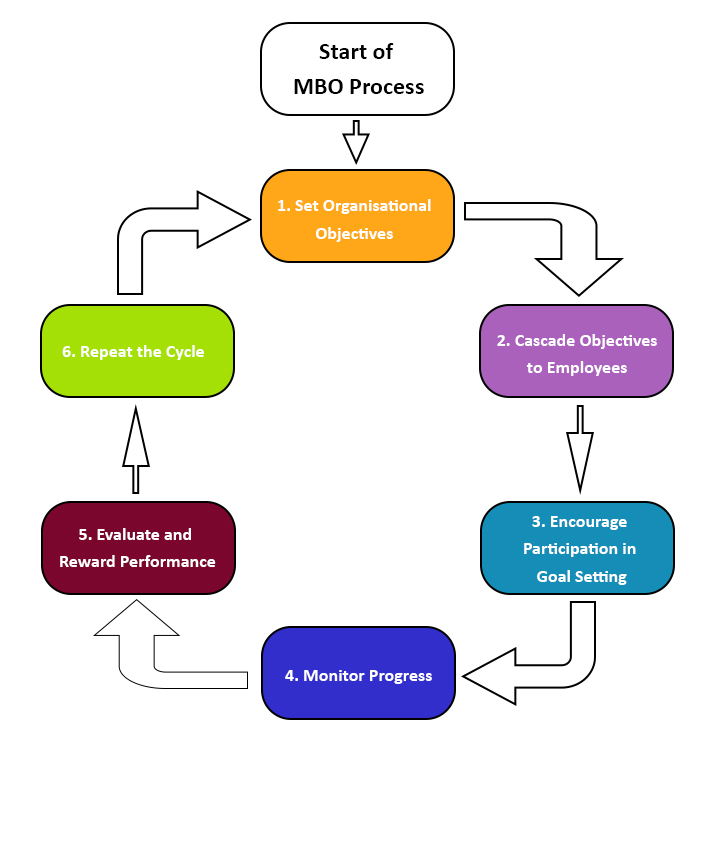12 Apr Management by Objectives
Management by Objectives describes the practice of aligning personal goals and objectives to your organisation’s overall goals, usually outlined in their mission statement. The idea is that having employees who understand their organisation’s mission and can see that their day-to-day tasks are contributing to it improves motivation, productivity and morale. For example, an employee who understands that their organisation needs to improve its customer services to compete with their competitors is more likely to make changes to their own personal work that can affect this. Aligning employee objectives to the organisation’s goals is common in modern day practice, but when the model was first developed it was ground-breaking in the performance management sphere.
The model was developed by Peter Drucker, in his 1954 book, ‘The Practice of Management”. The author was not the first person to suggest the practice, but he pulled together various models to create this flowing system. The model has laid the path for modern performance strategies, most notably forming the foundations for balanced scorecards and the work of George Odiorne, for example his book, ‘Management Decisions by Objectives’.
The main advantage of implementing the model in your organisation is an improvement in your overall organisational performance. Having all your employees working towards their own personal goals, which are neatly aligned to their organisation’s mission, will ensure every task they complete contributes to the organisation’s performance with maximum effectiveness. It is also an excellent tool for prioritising work and managing time, as employees know the exact importance and urgency of each task, in the organisation’s eyes. The tool can be used in team briefings, appraisals and to direct delegation to have maximum effect across the organisation. However, the tool does have some limitations which make it unattractive to use in certain situations. For example, the model can be costly and time-consuming to implement, in which case it may not be worthwhile in small businesses. It also requires the organisation’s full commitment, as if the mission statement isn’t accurate or individuals do not follow their set guidelines the alignment will not be efficient. A system for tracking goals and performance must also be in place for the initiative to be successful, which may rely on a high volume of resources.
Below we have explained how the 6-step process of Management by Objectives occurs:
Step One: Set or Review Organisational Objectives
Organisational objectives must be clear and concise and need to be set before the process can go any further. They are generally set out in the company’s ‘mission statement’ and senior management will sit down to discuss which direction they wish to take the organisation in. It is important that measurable targets are set here, so performance can easily be measured against their targets.
Step Two: Cascade Objectives Down to Employees
Next, targets for business units, departments, teams and individuals need to be set. It is important they these targets are agreed upon at each level and they align so that completion of a task at the individual level contributes to the targets at higher levels.
Step Three: Encourage Participation on Goal Setting
All individuals should be involved in the goal setting process, for two main reasons. Firstly, individuals find it easier to reach targets they have set themselves. This is because they fully understand what is expected of them and how to get there. Secondly, the input of all employees may reveal issues or areas of success that senior management isn’t aware of. This means the targets set will deal with any issues and build on previous successes better than if these individuals were not involved.
Step Four: Monitor Progress
Once targets have been set, progress in completing them needs to be monitored. This ensures progress is being made, so that any individuals or team slipping behind can be highlighted. Monitoring progress is also a good method of revealing which methods are not contributing to the overall success of the organisation.
Step Five: Evaluate and Reward Performance
In order for individuals’ contributions to feel valued and for them to be motivated to continue to perform, feedback and recognition is crucial. This may be in terms of emotional support or financial benefits. This is also an excellent opportunity to link organisational success to individual achievements.
Step Six: Repeat the Cycle
Completing the process once is likely to lead to an improvement in organisational performance, however, it is not likely to lead to long-term success. For this reason, it is important to ensure the process is repeated over and over again. You can use lessons learnt, regarding what went well and what did not, to make each cycle more and more effective.
Drucker, Peter F. (1954). The Practice of Management. New York: Harper & Row, 1954. Print.
Odiorne, George S. (1969). Management Decisions by Objectives. Englewood Cliffs, N.J.: Prentice-Hall, 1969. Print.


